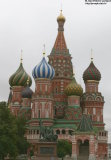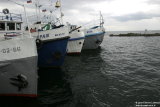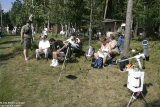2008 eclipse in Siberia


2008 eclipse in Siberia |  |
18 years and 10 days after my first total solar eclipse, on July 22nd, 1990 in Finland ; one saros had elapsed, and that same eclipse (затмение солнца) was repeating, on a shifted path which brought me in Siberia, on the shore of the Ob river (Об) near Novossibirsk (Новосибирск).
The trip began in Moscow, where several eclipse chasers, from U.S.A., England
and Scotland (Carole, on her second eclipse after a first... in Antarctica) were
gathering.
Have a look at the
Ben Cooper
site. He was a member of the group.


We quickly left to Irkutsk and lake Baïkal, in order to do a bit of tourism before the eclipse. On a low wall in Irkutsk, a grafitti was saying "Olga K., I love you more than the sun".





From Irkutsk, a two days transsiberain trip, with a sometimes not promising
weather, carried us to Novossibirsk.
NB: The lonely glass next to Fergus, Ann and Carole is mine.



But, once arrived, the weather was as perfect as we could dream... maybe even better.

The site coordinates and the eclipse circumstances.


The cumuli which did form during the morning started to disagregate in early afternoon, and the sky was perfectly clear almost an hour before first contact.
The strong wind was lifting a lot of dust and light particles which show up,
illuminated by the remaining sun, on the "diamond ring" picture.
The prominences photographs were snapped at the second and third contacts.




The corona picture above, is a composite of the 24 photographs shot during the total phase at exposure times ranging from 1/1000th to 2 seconds ; then processed to enhance the radial structures of the corona. The second picture hereunder is a radial gradient of the corona, it shows the magnetic structures ; this gradient was used in the processing of the composite.


All these eclipse photographs were shot automatically by my EOS 10D controled
by the softwares gPhoto2
and Sciatrope on my iBook.
Sciatrope uses a connection with a GPS and the eclipse elements to compute its
precise circumstances on the observation site, and trigger shutter release
(or any other action) at given times during the eclipse.
The photographs were processed with
dcraw for converting (with
dark frames substraction) of Canon RAW files,
Lynkeos for flat field calibration,
alignment, stacking of photographs, processing of the composite and final adjust
of the colours, contrast and brightness,
The Gimp for the final assembly of the corona,
prominences and the moon.